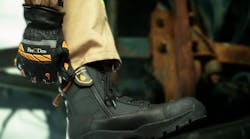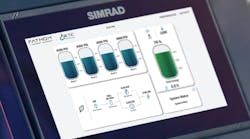As thermal imaging becomes a more integrated part of normal fireground operations, more applications are discovered, more techniques are developed, new knowledge is gained and, ultimately, more need for training is created. While this speaks volumes about the value of the technology, this type of proliferation can also create so many “possibilities” that it can appear as an opportunity overload.
Among the latest, greatest uses and techniques, the basics never change and the basics are all you really need to use a thermal imager appropriately and safely. A thermal imager is like any other tool on the fireground: properly used, it saves lives and property; improperly used, it can injure firefighters. Firefighters should regularly train with this new tool, carefully avoiding the “Five Don’ts of Thermal Imaging.”
1. Don’t lock-on to the image. Structural firefighting is still the primary use for a thermal imager, mainly because of the ability to restore sight to the firefighter in an otherwise blind environment. As a result, search times are dramatically reduced, while search accuracy and firefighter safety are greatly improved. But regained visibility also brings out the natural human tendency toward succumbing to habits. Because the thermal imager gives back the sense of sight, firefighters are often tempted to “lock-on” to the display, encouraging them to navigate primarily with their eyes. This is how we navigate our normal day-to-day lives so when sight is restored, habit takes over. This can be dangerous.
The potential risk is true tunnel vision, with firefighters diverting all of their attention to the viewing screen while neglecting their immediate surroundings. Firefighters may miss areas in their search, fail to see objects outside the camera’s immediate view or be unaware of dangerous changes in the environment. If firefighters rely only on their eyesight to enter a structure, they will most likely need to rely on their eyesight to exit a structure. Therefore, if firefighters lose the use of the thermal imager for any reason, they risk becoming immediately disoriented.
Back to basics ? Use the thermal imager to scan a room and build a “mental map.” As you navigate through a structure, take the thermal imager away from your view. This not only allows for faster team movement, but it also tangibly reinforces the “mental map” built with the thermal imager and enables you to maintain reference points in darkness.
2. Don’t mistake sight for safety. Historically, firefighters crawled primarily for the cleaner air, cooler temperatures and better vision found near the floor. While this is true to some extent today, self-contained breathing apparatus (SCBA) and modern turnout gear have somewhat de-emphasized the original benefits. Now, a major reason firefighters still crawl is to avoid tripping over or falling into hazards. Thermal imagers, however, remove the sense of darkness and the blinding effect of smoke, giving firefighters the ability to see furniture and doors. As a result, they can be tempted to assume it is safe to walk.
When using a thermal imager, do not confuse the ability to “see” with the presence of a safe environment. Sight with the thermal imager is not the same as sight with your eyes. Depth perception and peripheral vision are reduced with a thermal imager and some things look different on the imager. Puddles of water on the floor may appear to be holes in the floor and in order to walk with a thermal imager, the firefighter would have to use it constantly, requiring “locking on” to the imager. This violates “Don’t” number 1.
Back to basics ? Using a thermal imager should not stop you from crawling, with or without the imager.
3. Don’t think all victims are “white” on the screen. It is an unfortunate truth that few fire departments have regular access to structures in which they can light training fires. Without access to live-fire training, firefighters must resort to drilling in ambient environments. This strategy can be effective for working on skills such as hoseline deployment, SCBA drills, entanglement drills and the like. However, with thermal imagers it can be problematic.
When firefighters train in non-fire environments, humans are always displayed as white as people are typically warmer than their environment. The problem is that structure fires are not ambient environments, and a search for a victim may be performed in rooms where surface temperatures can exceed the heat of a person or more. This means that when firefighters are searching in actual emergencies, humans may not be the hottest items in the room!
Back to basics ? During thermal imager training, firefighters should be constantly reminded that a human may show as white in a cool environment, gray in a warm environment or black in a heated environment. When training in ambient environments, consider using rescue dummies to help reduce the “hot” profile, and encourage the identification of “victims” by shape. If you have infant rescue manikins, you can even place them in a refrigerator or freezer for a time prior to training in order to change their appearance on screen. Train on shape, not on shade when practicing search techniques.
4. Don’t have unrealistic expectations. No tool can perform every task. Some might argue that the halligan bar can do anything, but even this multi-purpose tool has limitations. The thermal imager, just like every other tool in the fire service, has limitations.
Thermal imagers do not “see through” buildings or people. One cannot “look” through walls, floors or major obstructions to find victims. (Thin obstructions, such as blankets or single sheets of paneling, may receive enough conducted heat from a victim to show a difference in surface temperature. Do not confuse conducted heat transfer with “seeing through” an object.)
While glass is transparent to light, it is nearly opaque to infrared. The same is true with water. During exterior size-up efforts, thermal imagers cannot be used to see through closed windows to find victims or to directly observe fire conditions. Inside a structure, an activated sprinkler head may appear as a black cone showering down, masking nearby victims or fire from the thermal imager.
Back to basics ? Use your thermal imager as frequently as possible to familiarize yourself with these limitations.
5: Don’t forget the basics of firefighting. If there were only one “Don’t,” this would be it. You absolutely, positively must remain proficient at all the skills you learned before your department purchased thermal imagers. Thermal imaging is a valuable technological tool; however, thermal imagers will not put out the fire. Firefighters need to engage in solid, fundamental firefighting to ensure their own safety and the proper completion of their goals.
Back to basics ? While the thermal imager will make search efforts easier and faster, it should not supplant the standard practice of right- or left-hand search patterns to maintain orientation. While the thermal imager helps to monitor structural integrity, it cannot see hidden trusses, nor can it make compromised trusses carry their loads longer. Firefighters still need to be aware of the structural limitations of a building and the dangers therein. Stick with the basics of firefighting and enhance, not replace, those skills with a thermal imager.
In conclusion, don’t become overwhelmed with all of the things you can do with a thermal imager; rather, stay focused on what you should be doing (and not doing) in order to improve your odds of success, operate more efficiently and, most importantly, stay safe.
BRAD HARVEY is the Thermal Imaging Product Manager at Bullard. He is a veteran of public safety as a firefighter, police officer and paramedic and is certified through the Law Enforcement Thermographers’ Association (LETA) as a thermal imaging instructor. Harvey has worked as a high-angle rescue instructor and is a certified rescue technician and fire instructor. If you have questions about thermal imaging, you may e-mail him at [email protected].





